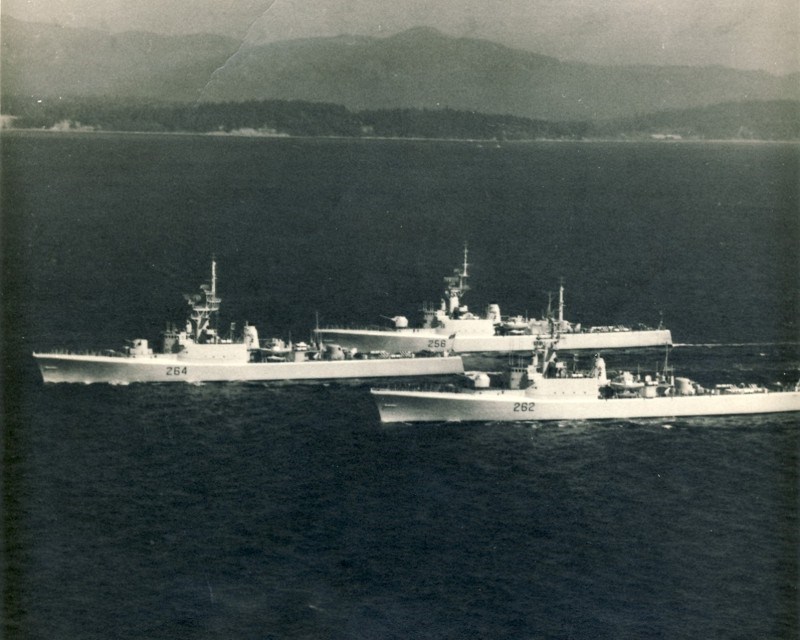Smith Thomson followed his grandfather’s and father’s footsteps, when at the young age of 17, he joined the Canadian Navy.
His family hails from Peterhead, Scotland and moved to the Winnipeg area in the 1920s. His father was a blacksmith by trade and served in the Royal field artillery in England during the First World War. A severe wound was near fatal, but his grandfather survived and continued with the Scottish Highlander regiment as a pipe major.
Thomson’s sister joined the armed forces in Manitoba. He also had a brother in the Navy and another with the technology branch in the armed forces.
"I joined the Navy fully knowing what I was getting into. Growing up, I heard many stories and felt it was necessary and expected of me," said Thomson.
When he enlisted, Thomson was to receive three to four weeks of basic training but once the Navy found out that he had a welding ticket (earned as a high school apprentice with the Canadian National Railroad) he was bumped from training directly to the shipyard in Halifax where he worked as a welder on destroyer ships that were being rebuilt.
"Ships at that time were riveted together which took too much time. Times were changing and welding became more practical and quicker. I was very excited when I was first drafted to work on a destroyer at sea. I never got seasick much like many of my fellow seamen. I believe it was due to being raised on the prairies.
“I not only was responsible for welding and maintenance of the ship but I was also in charge of fixing the plumbing.”
In 1944, the ship was hit by a “glider bomb” and the engine room sustained major damage, Thomson said. For Thomson, the attack was very personal as in the explosion, “I got hit in my leg and I received a broken leg. I spent seven months in an English hospital.”
When he got out of hospital, he was sent back to Canada, landing at Halifax where he decided to take some courses that dealt with learning the techniques needed to paint ships. “I also was responsible for teaching the course to others.
In November 1945, months after the war had officially ended, Thomson was discharged. He said that was when the Second World War ended for him.
Soon after he returned home, Thomson said he felt the urgency in joining the reserves. It was a way in which he could keep in contact with his Navy buddies. He recalls thinking of his fellow comrades more as family. That was what came from living in close quarters for months at a time.
Looking for permanent employment, Thomson returned to the Canadian National Railroad for more training in the blacksmith profession. He finished his apprenticeship, but Thomson noted that the trade had changed and blacksmiths were no longer in demand as compared to the years prior to the war. Thomson turned his attention to Snow Lake, Manitoba where he found employment on the construction side of the mining project. He spent three years working above ground and 3.5 years working underground.
When war broke out in Korea in the early 1950s, Thomson was called back for duty with the Navy.
"I made one trip overseas to Korea and the tour lasted between 10 to 15 months. I was responsible for welding and general maintenance on the ship. We faced a lot of challenges but counted ourselves as very lucky as we never sustained any really damage from enemy attacks. But our sister ship was hit and badly damaged. There were lives lost.
“We made it back in one piece and I was responsible for working on old ships. When the war was over, I returned to school and took painting classes. In 1953, I was drafted back to work on the HMSC Quebec, a cruiser ship, that was responsible for travelling to England to protect the British Isles for the coronation of Queen Elizabeth II.
“The cruiser ship was one of the biggest ships I had every worked on. There were over 500 people on the ship and it was very different from the destroyer where I worked with a crew of only 190. I was upgraded from a seaman to a fourth class shipwright. After doing its duty in England, the cruiser toured the Mediterranean, south of France.
“In 1954, I was back in Halifax, where I spent six months working on a destroyer, learning training protocols.”
Thomson said he spent the better part of his life on a ship welding and ensuring the safety of the ship and the seaman on it.
Throughout his career, Thomson said he had worked on numerous ships that included: the Chippewa, the Stadacona, the Cornwallis, the Quebec, the Donnacona, the Heron, the Bonaventure, the Corpe Scott, the Capde La Madeline, the Gloucester and Bytown.
In 1961, Thomson said he had enough of the Navy and he was honourably discharged.
"I was very proud to have been able to serve and protect my country. There is no better place to live than in Canada. I received five medals during my time in the Navy.”
In total, he had served for 17 years in the Navy.
Returning to live in the Winnipeg area, Thomson went back to work in the mining industry. He worked in mines all over Western and Northern Canada.
"Working on ships has always been a passion of mine and my favourite ship on which I worked was the Heron. It was a very closely-knit family environment on the ship,” said Thomson.
In 1990, he retired from the work force and moved his family from Winnipeg to Stuart, B.C. He went into business for himself, supervising major construction projects across Western Canada. In 2014, he and his wife moved to Sturgis to “fully retire.”
Now at the age of 90, Thomson remains physically and emotionally active and is enjoying his retirement.




